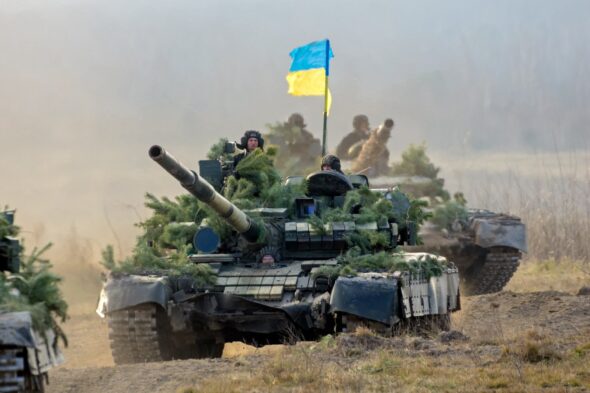The current situation on the front line of Ukraine’s war against Russia is the only time when the West can support Kyiv and provide it with the necessary equipment for defense. Russia will attack with a renewed force, and it is now regrouping and replenishing the losses. Ukraine doesn’t have this comfort. It’s time to act instead of leaking information on what is being planned – writes Mariusz Marszałkowski, editor at BiznesAlert.pl.
It’s been 40 days since Russia invaded Ukraine. This war is becoming more brutal every week. The constant bombardment of towns and villages, public buildings, is accompanied by looting, rape and mass killings of civilians. The most abhorrent example of this was seen in the town of Bucha near Kyiv, where, according to the local administration, more than 400 people were slaughtered. Unfortunately, there will be more cases like Bucha. We are already hearing about reports of mass killings in the area of Brovary, east of Kiev, in the region of Sumy and Chernihiv. Mariupol is also experiencing an incessant offensive, which targets especially civilians.
The Russians are installing their occupation administration in the conquered southern regions of Ukraine, recruiting collaborating police, or even summoning men to appear before military recruitment commands in order to draft them into the Russian army.
In recent days, the Russian troops have started retreating from the previously occupied positions in the Kiev, Chernihiv and Sumy regions. During the withdrawal, the occupation forces used scorched earth tactics, destroying everything that could not be looted and sent to Russia. The Russian army is following the worst Soviet and Nazi patterns, which is especially repulsive in the context of the propaganda goals of the „special military operation in Ukraine ” or „denazification” of this state.
The retreat of the Russians from the northern regions of Ukraine is by no means the end of the war. There is still a long way to go before this conflict concludes. The withdrawal of the Russians from the Kiev, Chernihiv and Sumy regions is only the end of the first stage of the invasion. Generally speaking Russians lost this ending. Why lost? Because every military operation has its strategic objectives. The statements of Russian politicians made in late February and the movement and offensives of Russian forces, suggest that the primary, maximum goal was to conquer Kyiv and replace the government with one that will collaborate with Russia. The time frame in which this goal was supposed to have been achieved is less important. Since the beginning of March, the Russians have been practically stuck in place, without having achieved any major successes, including the encirclement of Kiev. In recent weeks, the Ukrainians, on the other hand, have begun to conduct encroachments and local counterattacks, as well as harassing the entrenched Russians with effective artillery attacks.
It is likely that the Russian military command managed to convince the political factor that prolonged holding of positions in the north of Ukraine will lead to further losses, without achieving the intended goals.
However, the withdrawal of the Russians cannot be seen as a complete failure. The forces that left Ukraine, will be directed to other sections of the front, mainly in the Donbas. And this is where the second phase of the operation begins. After the initial successes in the Donbas, the offensive there also slowed down. Russian troops were too stretched, which caused both logistical problems and issues with insufficient air support for troops fighting on the ground. Transferring the main burden of the offensive to the Donbas means it will progress in line with the art of running offensive operations, including secured logistics and pacification of the areas behind the front lines. In the case of the northern part of the front, neither the proper logistics nor the rear of the offensive formations were secured, leading to numerous ambushes, including on the already inadequate supply convoys for the fighting troops on the front line.
Apart from the movement of the ground troops, the air force is also redeploying from military airports in Belarus to those that are located in direct distance from the border with Ukraine on Russia’s territory.
The whole process of redeploying Russian forces may take two to three weeks, including replenishment of losses of both equipment and personnel. This period gives the Ukrainians some time to prepare and draw additional forces to the east, while maintaining adequate forces in the liberated northern areas. There is still a risk that the Russians will use the current turmoil to launch surprise attacks in the event that the Ukrainians fail to secure the northern border adequately. In addition, it is still not possible to exclude Belarus’ involvement in the war, which, however, seems less likely at the moment than three weeks ago. It is no secret that neither the Belarusian society, nor the army are overly eager to die for Russia’s geopolitical delusions.
Ukrainians are also preparing for the escalation in the east. According to unconfirmed reports, the Ukrainian command sent 12 brigades to the east part of the country – both reserves released after securing the suburbs of Kyiv, and the newly formed units, which were trained in the west of the country. It is still being discussed whether Russia will use weapons of mass destruction. At this point it is difficult to imagine that such weapons would be used against Ukraine. Russian losses, although large, do not paralyze the offensive capabilities of this country. The Kremlin still has a lot of reserves available from all over Russia. Also in terms of equipment, the situation in Russia is far from being tragic. As at 4 April, the Russian losses, calculated on the basis of photo evidence collected by the Oryxspionskop portal that tracks losses on both sides, include 421 basic tanks, out of which 199 were destroyed. These figures represent 13 percent of the total number of tanks owned by the Russian military, which is estimated at 3200 vehicles (peacetime, not including mobilization stocks). It is worth noting that among this number there are also machines owned by the Donbas militia, mainly from the T-64 and T-72A/B series. As long as Russians do not run out of all conventional options, they will not use WMDs. However, this cannot be completely ruled out. The invasion and its scale has shown that Russians are unpredictable, but the possible usage of nuclear weapons would require certain preparation in terms of propaganda, which has not been noticed yet.
According to American intelligence, Vladimir Putin wants to have something to celebrate during the victory parade on 9 May. However, this does not mean that by then the war will be over. Capturing Mariupol could be that much wanted success, and I believe that this will be the military goal in the coming weeks. This would pave an onshore way to Crimea. In the future, the goal may be to capture Zaporizhzhia, Dnipro and a further offensive in the direction of Nikolaev. The minimum option is capturing the administrative borders of the Luhansk and Donetsk oblasts. Probably also, the Russians will want to encircle the Ukrainian forces in a killing box in the area of Donbas, by attacking them from the direction of Izium in the north and Volnovakha in the south. Such an operation requires a large force, which may arrive there soon.
For the last 40 days, Ukraine has been bravely defending itself, but it has also incurred huge losses both among soldiers and equipment. Unlike Russia, Ukraine is not able to quickly regenerate or repair damaged machines or replace them with those coming from warehouses. First, these warehouses for the most part were already exhausted after 2014, second at this point there is nowhere to repair these machines. Most of the Ukrainian arms plants were razed to the ground during Russian missile attacks. The Russians, meanwhile, probably ordered their entire arms industry to work in a three-shift system to make up for losses and shortages, for example, in ammunition. NATO and hardware support play an important role here. Contrary to popular belief, this is not a war of grenade launchers and light infantry (although this is the image that is being deliberately pushed), but of artillery and heavy armor, although at first glance they are not visible. It is therefore necessary to support Ukraine not only with light anti-tank and anti-aircraft weapons, but also with weapons of literally heavier caliber. This will determine whether after fighting off the attacks, Ukraine will be able to launch a counteroffensive and beat Russia. A peace deal where Ukraine would loose a third of its own territory would, in the long term, result in a drama very similar to the war.
The coming weeks will be crucial for the future of the ongoing war. Ukraine, together with the West, have a short window of time to acquire as much support as possible. This must not be wasted, because the third phase of the operation and the next reorganization of Russian troops may not actually need to happen.









